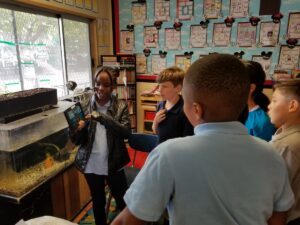 Weather Watchers
Weather Watchers
Originally Published December 3, 2018
The Weather Watcher Program was formed thanks the funding received from the to the Sol Hirsh Educational Fund from the National Weather Association and their National Weather Association Foundation.
In this project, fifth graders will learn how weather occurs and will understand how to record weather parameters using weather stations installed in their classrooms in 6 community schools in the Los Angeles Unified School District (LAUSD) in the vicinity of the University of Southern California: 32nd Street School, Vermont Elementary School, Norwood Street Elementary School, Weemes Elementary School, Foshay Elementary School, and California Science Center. A Houzetek Digital Color Forecast Station will be placed in each of the 18 fifth grade classes.
The beginning of the structured weather lesson taught to fifth graders entails asking fifth graders what the word meteorology means. After discussion and defining the meteorology is the scientific study of the atmosphere, students are asked how do meteorologists forecast the weather? Students are then told that as scientists, we have just come up with a question but we need to also come up with a prediction or a hypothesis on how we think a meteorologist studies the weather. After that, it is explained that before we do the weather experiment we need to know a little bit more about how the weather works through two activities.
The first activity involves teaching the concept of high pressure systems and low pressure systems to the students. Students will also learn about the type of weather associated with each system. Next, a worksheet is distributed to the students. Printed on the worksheet is a weather map of the United States with labels, particularly H to represent a high pressure system and L to represent a low pressure system. Students will answer questions about the weather in various states using the weather labels as a guide.
The second activity entails understanding the process of cloud formation. using rubbing alcohol and foot pumps (as will be obtained with the aid of the grant money), as well as water and 2 liter clear plastic bottles with caps. The basic theory states that vapor can condense into clouds by adding pressure or adding more vapor. The rubbing alcohol is used to introduce more vapor. A thin layer of hot water is put into the water bottle. The foot pump is used to introduce more pressure in the system. The pump is quickly removed. Consequently, the pressure dramatically decreases and clouds form in the bottle. Lowering pressure (in the cloud bottle) results in air expansion and temperature lowering. As the temperature lowers, the gas molecules from the water stick together (condensation) and forms water droplets. Thus, clouds are formed when you go from high pressure to low pressure. The process is repeated with rubbing alcohol in order to obtain bigger clouds and emphasize the cloud formation process. This description of the cloud formation theory is taught to the students as the experiment is executed by the students. Consequently, students learn why low pressure systems are typically cloudy while high pressure systems are sunny.
Next, with a solid foundation of weather, the Houzetek Digital Color Forecast Stations (to be funded by the grant money) help the students to become meteorologists. Students will record data from these weather stations, including the temperature, pressure, and humidity. They will continue to record weather data daily in their science journals. After collecting for a week, students will note trends in the temperature, pressure, and humidity. From these trends, students will make predictions about what the weather will be in the future (i.e. whether it will be colder tomorrow or whether will it rain within the next few days). Students will continue to collect data, note trends, and make predictions about the weather.